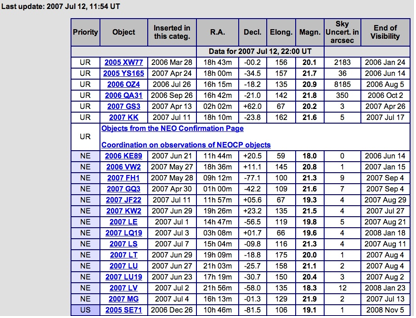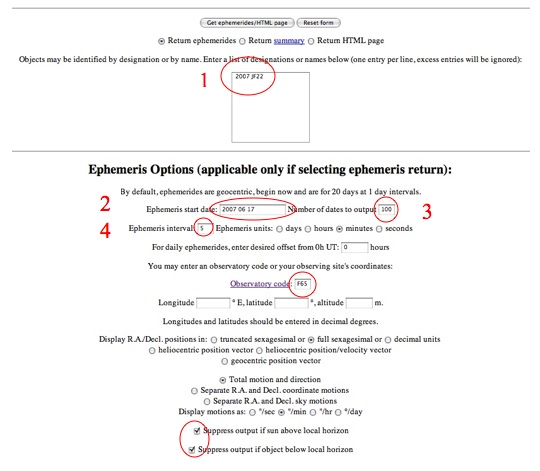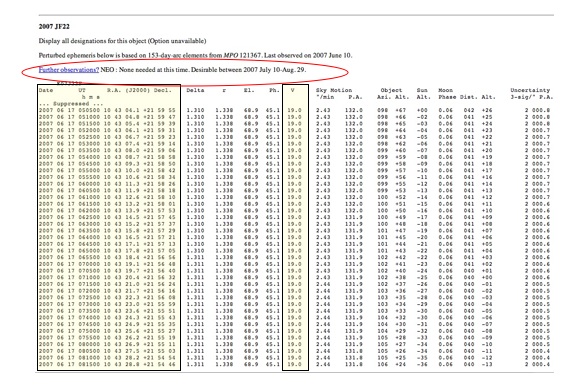Space to Grow
Asteroid Investigation
Selecting an asteroid to observe
Note: If you plan to use the practice data or other archive data from the Faulkes Telescope, you DO NOT need to complete this section. If, however, you are planning to take new data, you should study this section.
If you are observing in real time, the best way to select asteroids is to visit the Asteroid and Near Earth Object portal at the Faulkes Telescope web page. The UK team have developed a web page and documentation that shows you step-by-step how to select appropriate asteroids to observe.
If you are planning for a future observing session, you will need to use the actual websites underlying this Faulkes Telescope page.
- Select an appropriate date for your observations.
One of the key factors influencing this selection is the moon and how full it is. Asteroids are usually quite faint, so it is better to select a date and time around new moon, or when the moon is not in the sky.
- Spaceguard Priority List for Near Earth Asteroids
http://spaceguard.rm.iasf.cnr.it/servlet/PriorityListServlet
This list prioritises asteroids into URgent, NEcessary, USeful and Low Priority. An example list is shown in Figure 1.

Figure 1: A sample extract from the Spaceguard Priority List.The columns you need to check first are:
- End of Visibility – this date needs to be after the planned observations.
- Decl. – this is the declination of the asteroid in the sky. For Faulkes Telescope North, this should be larger than -20; for Faulkes Telescope South, this should be smaller than +20.
- Sky Uncert. in arcsec – indicates how accurately the orbit for the asteroid is known. The larger the number the more uncertain the orbit. For asteroids with very large uncertainties, there is the risk of the asteroid not falling in the image.
- Minor Planet Ephemeris Service
http://www.cfa.harvard.edu/iau/MPEph/MPEph.html
This site allows you to calculate an accurate position for your asteroids of interest on any date you choose. The opening page is quite long, but the important part is shown in Figure 2.

Figure 2: Sample input window from the Minor Planet Ephemeris Service.To generate the information for your asteroid:
- Input the name of the asteroid into 1.
- Input the date you wish to observe in 2 (the 17th June, 2007 in this example). Dates should be in YYYY MM DD form.
- Input a large number in 3. This is how many records it will retrieve.
- Input the number '5' into the Ephemeris interval field 4 and check the minutes button. Each of the records will be spaced by 5 minutes.
- Input the observatory code for Faulkes Telescope North (F65) or Faulkes Telescope South (413) in 5.
- Tick both suppress output options since you don't want to observe the object if it is below the horizon or if the Sun is up.
- Click on the Get ephemeris/HTML page button.
The output should look like Figure 3.

Figure 3: Sample output from the Minor Planet Ephemeris Service.The output contains a wealth of information, but the main things you need to check are:
The best dates to take observations (circled in red above). There is often a statement indicating when the greater astronomical community would like additional observations of this particular asteroid. This doesn't mean that you shouldn't observe it - all information is equally welcome in the world of asteroid tracking.
The brightness of the asteroid. This is given in the column labelled V. This indicates the brightness of the asteroid. For the Faulkes Telescopes it should be between 10 and 20. A magnitude less than 10 means the asteroid is too bright, a magnitude greater than 20 means that the asteroid is too faint to be imaged in an appropriate timeframe. In this example, the asteroid on this night is magnitude 19, which is doable with the Faulkes Telescope. The UK Faulkes Telescope team provide appropriate exposure times for particular magnitudes at:
http://faulkes-telescope.com/education/planning/exposures
The position of the asteroid at the time the observations will be taken. This is encompassed by the columns labelled Date, UT, R.A. and Decl.
- The Date is simply the date you indicated you would be taking the observations (in this example, the 17th June 2007).
- The UT is the Universal Time at which the object is at the given coordinates. You can see that the UT goes up by 5 minutes each time. This is what was specified earlier as the Ephemeris Interval. Note: in order to determine the best time to observe your asteroid in local time, you will have to convert from UT. For local time at Faulkes Telescope North, you should subtract 10 hours from the UT to determine the local time. For local time at Faulkes Telescope South, you should add 10 hours to the UT to determine the local time (11 hours during daylight saving).
- The R.A. and Decl. show the accurate position of the asteroid at that UT.
If you are observing in real time, when you are ready to observe your asteroid, you must look for the nearest UT and use the R.A. and Decl. given at that time.
Finding the asteroid
Return to the main page for this module
Exercitationem
Visi ut aliquid ex
Ut enim ad minima veniam, quis nostrum exercitationem ullam corporis suscipit laboriosam, nisi ut aliquid ex ea commodi consequatur.
Visi ut aliquid ex
Quis autem vel eum iure reprehenderit qui in ea voluptate velit esse quam nihil molestiae consequatur, vel illum qui dolorem eum fugiat quo voluptas nulla pariatu
Et harum quidem rerum facilis est et expedita distinctio.
